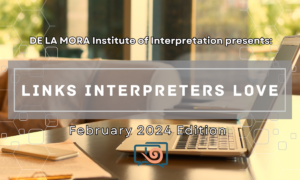
LiL: The Question Language Learners Need to Ask Themselves: Why?
Whenever one starts learning a new language, all kinds of questions come up immediately: “Which language should I choose? What’s the best way to go about learning a language? What should I learn first? How can I get over the embarrassment of making mistakes?” These are all perfectly valid questions, but there is one that people often forget about: Why?
The what and how questions are what we seem to focus on first above any others. These give us structure and substance, but in the context of language learning they only get us so far. More importantly, they don’t…
LIL: Which Type of Interpretation is Right for You?

Interpreters work in all sorts of places… from hospitals to court rooms to conferences, and they can make pretty good money. Becoming specialized or certified in a certain area (like legal or medical interpreting) can almost guarantee this.
Choosing a specialization isn’t quite as simple as picking one out of a hat. The area(s) you choose will alter your professional mindset and may change your life. There are many different specializations in interpreting, but we’ll discuss the three most common here.
Medical Interpreting:
You, the patient, and the doctor all have one goal: get the patient healed. This…
LIL: The Importance of Native Input While Learning a Language

http://www.shouldwe.org/uploads/issue/image/104/multilingual.jpg
As you’re learning a language, one common term you’ll hear thrown around classrooms and in books is input – how important it is, how often you should be getting it, how to get it, etc. Many people will just nod their head and play along when input is mentioned, but don’t actually understand what it is or realize just how important – rather necessary – it is for the learning process.
What is Input and How Does It Work?
Input is defined as sentences, words or utterances from native speakers of a language that, when…
LIL: But What About all the “Different” Spanishes?
“I’m from Argentina (or Peru, or Cuba, or Puerto Rico, or Guatemala)! What if I don’t pass the state oral exam because I’m not using the ‘proper’ form of Spanish?”
As a company that helps students prepare for various interpreter certification exams, we get this question a lot. The simple answer? Spanish is Spanish.
Now hold on – before you fervently tell me that there’s no way Castilian and Caribbean Spanish are the same, hear me out.
Spanish is one language. Castilian and Caribbean are two dialects of Spanish. So, what’s the difference?
 The main linguistic divider between a…
The main linguistic divider between a…
LIL: A Recipe for a Good Sight Translation: Mixing Modes
Sight translation exists somewhere in the gray area between simultaneous interpretation, consecutive interpretation, and translating. It draws on some of the main skills used in the three other modes of interpretation and translation, without totally eclipsing any of them. Knowing what skills are involved can help us understand what we need to practice a bit more, and what we’ve already mastered from our “main” method of interpreting.

Add a dash of consecutive
In consecutive interpretation, we get to hear and understand an entire utterance before interpreting it, allowing us to take notes and have a few extra seconds to figure…


















